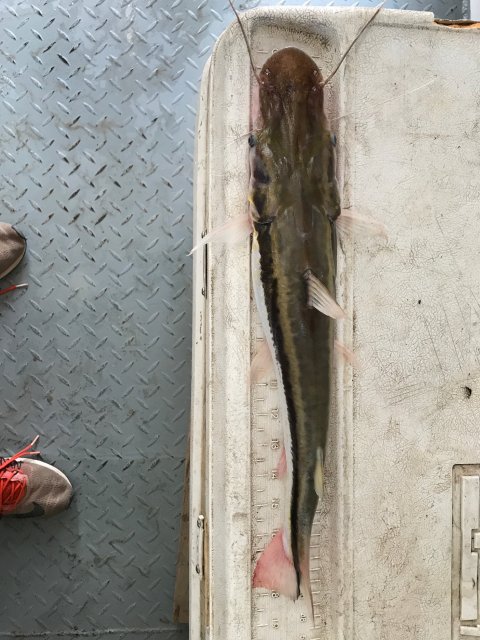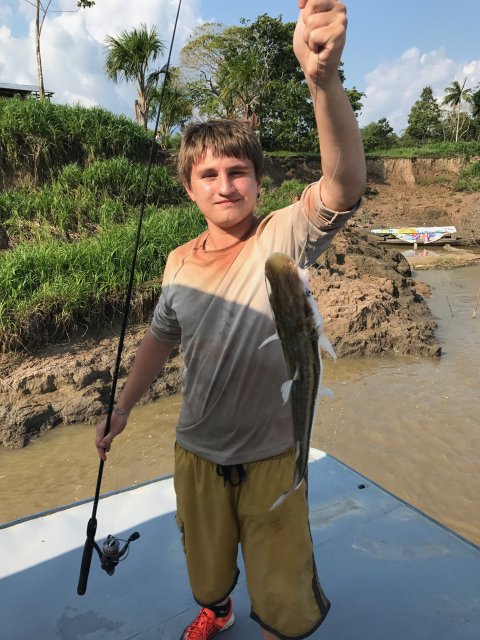Like Viktor, I've done a ton of reading on the subject of Lima vs. Elongatus. I believe that more should be done in terms of properly defining the area that both species are sympatric in and that may hold the key to properly IDing this species.
I agree with Viktor in saying that these are definitely a slower growing species. I've kept nearly a dozen Sorubim over the years and while they grew swiftly up to 8", it has taken them much longer to get bigger than that. I have one specimen I purchased 6 years ago now that was at least 10-12" long when I bought it (large enough to eat adult Rainbowfish was the complaint of the fellow I bought it from) and as of 2 weeks ago it was only about 12" standard length, about 14" TL counting the trailers it has started developing on its caudal fins (which I have not seen before in any of my others. I also have a specimen I got about 3-4 years ago that was about 8" TL when I bought it off a gentleman and it is now about 12" TL. My 3rd Sorubim is slender and about 13" TL, I bought it recently from a gentleman who owned it for about 5 years. Now while it is true that I do not push for super fast growth on my fish, they are in large enough tanks and fed well enough that they are not stunted. Based on these timelines I would assume that these fish are S. elongatus, though the captive lifespan is unknown on Sorubim, though I would assume it is 10-15 years. Certainly, true S. lima grow quickly enough in the wild, as documented here, which does take into account true S. lima and not elongatus. http://www.scielo.br/scielo.php?pid=S1519-69842004000100014&script=sci_arttext
Oddly, it seems that many European hobbyists come across more true Lima than Elongatus, at least from what I can glean from MFK which is by no means comprehensive, whereas in the states Elongatus is much more common. I recently went to a store selling many juveniles at extremely similar sizes, but with some being very, VERY visibly more slender body shape wise, even at 5" SL. They were all labelled as S. lima and without a shadow of a doubt these all came from the same location, leading less credence to my thoughts that possibly European Sorubim are from a different collection site, though it is possible. I have seen Sorubim over 2 feet in the flesh multiple times at the Shedd Aquarium in Chicago and despite my efforts to photograph them from every available angle I could not find a way to distinguish them from my S. elongatus with the exception of the extreme size difference.
My belief at this point in time is short of measuring vomerine teeth is that Back's method of examining the gular apex and determining where the mandibular barbel insertion is key to this species. All 3 of my older, smaller Sorubim have barbels equal to or posterior to the apex so I have reason to believe at this point from what others have said that that may be the best determinant for smaller Sorubim. I have examined a few smaller specimens for this that also came up elongatus but they were 7" SL.
Just my two cents, these are my favorite species and discerning who is what has been an obsession for many years now. Good luck with IDing, even if it takes you a bit of time to grow the fish out.
I agree with Viktor in saying that these are definitely a slower growing species. I've kept nearly a dozen Sorubim over the years and while they grew swiftly up to 8", it has taken them much longer to get bigger than that. I have one specimen I purchased 6 years ago now that was at least 10-12" long when I bought it (large enough to eat adult Rainbowfish was the complaint of the fellow I bought it from) and as of 2 weeks ago it was only about 12" standard length, about 14" TL counting the trailers it has started developing on its caudal fins (which I have not seen before in any of my others. I also have a specimen I got about 3-4 years ago that was about 8" TL when I bought it off a gentleman and it is now about 12" TL. My 3rd Sorubim is slender and about 13" TL, I bought it recently from a gentleman who owned it for about 5 years. Now while it is true that I do not push for super fast growth on my fish, they are in large enough tanks and fed well enough that they are not stunted. Based on these timelines I would assume that these fish are S. elongatus, though the captive lifespan is unknown on Sorubim, though I would assume it is 10-15 years. Certainly, true S. lima grow quickly enough in the wild, as documented here, which does take into account true S. lima and not elongatus. http://www.scielo.br/scielo.php?pid=S1519-69842004000100014&script=sci_arttext
Oddly, it seems that many European hobbyists come across more true Lima than Elongatus, at least from what I can glean from MFK which is by no means comprehensive, whereas in the states Elongatus is much more common. I recently went to a store selling many juveniles at extremely similar sizes, but with some being very, VERY visibly more slender body shape wise, even at 5" SL. They were all labelled as S. lima and without a shadow of a doubt these all came from the same location, leading less credence to my thoughts that possibly European Sorubim are from a different collection site, though it is possible. I have seen Sorubim over 2 feet in the flesh multiple times at the Shedd Aquarium in Chicago and despite my efforts to photograph them from every available angle I could not find a way to distinguish them from my S. elongatus with the exception of the extreme size difference.
My belief at this point in time is short of measuring vomerine teeth is that Back's method of examining the gular apex and determining where the mandibular barbel insertion is key to this species. All 3 of my older, smaller Sorubim have barbels equal to or posterior to the apex so I have reason to believe at this point from what others have said that that may be the best determinant for smaller Sorubim. I have examined a few smaller specimens for this that also came up elongatus but they were 7" SL.
Just my two cents, these are my favorite species and discerning who is what has been an obsession for many years now. Good luck with IDing, even if it takes you a bit of time to grow the fish out.




